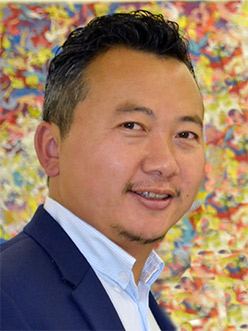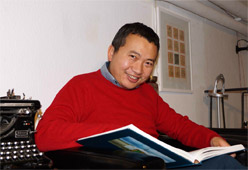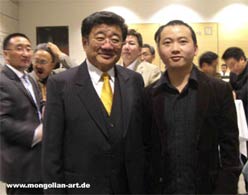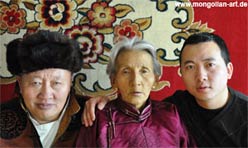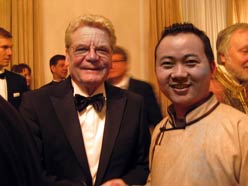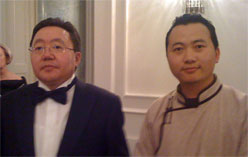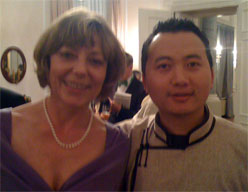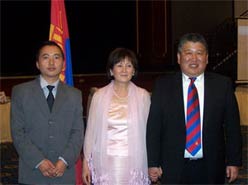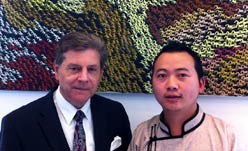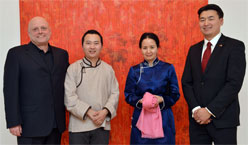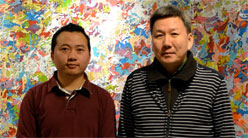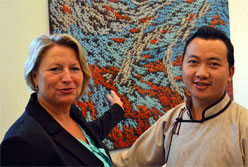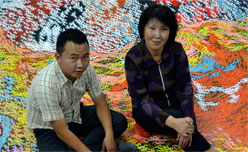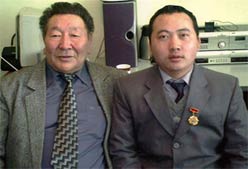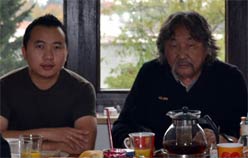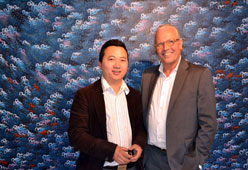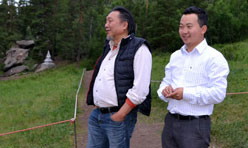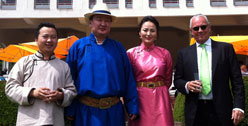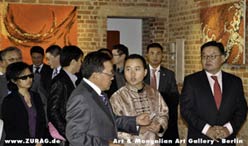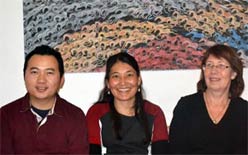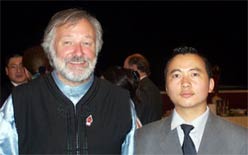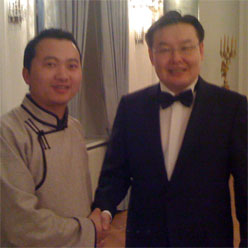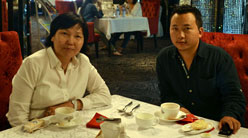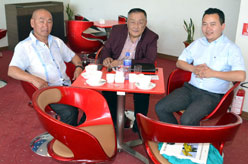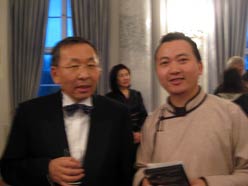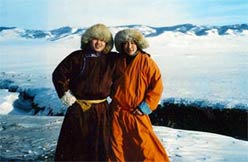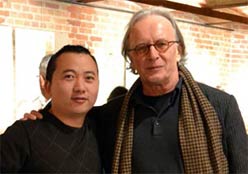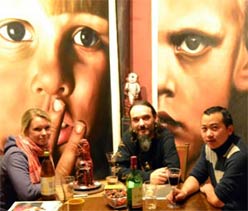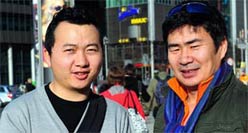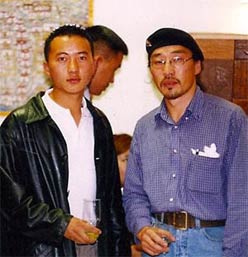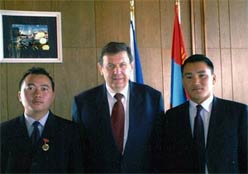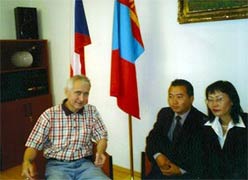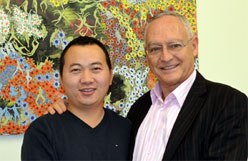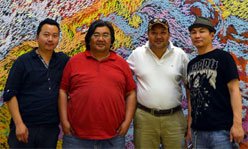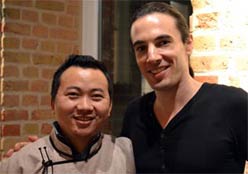OtGONBAYAR Ershuu M.A.
OtGO is Artist/Painter – Art Historian –Curator – Collector – Autor
Ershuu Otgonbayar – WHITE
Opening Gallery Peter Zimmermann, 6/12/2015
Crossing
borders, moving to another culture holds the promise of freedom but
also danger. Those who want to penetrate the wilderness between two
worlds do so at their own risk. They will not be safe from surprises or
illusions. Each step can mean failure or the chance to push forward to
new horizons and insights. And this is true for both the artist and the
observer.
We stand in front of canvases which become landscapes. Unknown and yet strangely familiar worlds open up in front of our eyes. Wilderness without horizons in which mysterious life enfolds. A teeming mass of figures is woven into a dense structure of multi- layered traces of colour.
What from a distance looks like a surprising, lively reincarnation of informal structures, upon closer view turns out to be a holey text at the level of post modern irony. The surface, more closely viewed, is a graphical weave of comic-like figurations in blissful innocence and holy solemnity, without the slightest hint of satire or contemporanity.
What we see here is, in the truest sense of the word, multi-layered. We see a varnished stacking of abstract colour gradations, on the one hand, and a surface entanglement, a swirling and networking of a finely engraved agglomeration of stencilled animals and human beings, on the other hand. And we see: a virtuoso interweaving of both these separate and perspective-less levels of the composition. This is far from the customary conventions of perception which we know. Abstraction and figuration do not merge, but rather, develop – separately – their full antagonism.
But instead of the pictorial universe exploding and falling apart, an unexpected huge ornament, such as never before seen, springs from the controlled contradiction on the canvas. It is visually shimmering, iconographically ambivalent. It is fascinating: this ostentatious contradictoriness between the chaos of figures and the obsessive systematic.
In short: what we see is beyond one-dimensional approaches of description and interpretation. So be careful entering unknown terrain, which so rightly arouses curiosity.
This much can be said at the beginning of our journey into the unknown: these surprising paintings are HYBRIDES. They mark an undetermined place of cultural overlap. Sociology defines hybridity as a phenomenon which arises in situations in which antagonistic thought and incompatible logics from different cultures, social or religious settings are combined as new thought and behaviour patterns. Ideally, in these situations cultural dynamic can be created. And, I might add, in such a constellation the chance of real renewal can arise.
Erschuu Orgonbayar, whose artist’s name is OtGO, was born 18 January 1981 on the outskirts of Ulaanbataars, Mongolia’s capital. He was the sixth son of Erschuu, an ordinary worker. Located between Central, North and East Asia, Mongolia, a land of steppes and half desert, is five times as large as Germany and with a population of 3 million the most sparsely populated settled independent state in the world. For thousands of years nomads lived here. They were unified into an empire for a short period of 70 years by Dschingis Khan in the 12 century. Since then the country has been under the spiritual influence of Buddhism and Lamaism, old religions which, of course, survived the Socialist People’s Republic, the second oldest after the Soviet Union.
The painter OtGO grew up with seven brothers and sisters and an adopted brother at the other end of the world. His artistic talent was evident at an early age, and OtGO studied painting at the University of the Arts in Ulaanbaatar in the 1990s. Following that, he devoted six years to the self-study of traditional Mongolian miniature painting, working from time to time as a restorer. He went straight to the sources: for two years, he travelled across Mongolia like a nomad, on foot and on horseback, by ship and by plane to the most out of the way places, to villages and monasteries. He came across many different kinds of people and lived together with his teachers. His love for his country and the religion of his ancestors is rooted in this period of time.
OtGO acquired the techniques, the iconography and knowledge of the spiritual background of Mongolian miniature painting in the Buddhist-Lamist monasteries in the traditional teacher-pupil relationship. He also began to make all the utensils for painting himself. He became a master of Thangka painting, which, for OtGO, is more philosophy than handwork. A Thangka is a scroll painting in tantric Buddhism. It is displayed in temples and home altars, and carried in processions as an object of meditation.
Using the finest of brushes and without any optical aids, OtGO painted hundreds of Buddhas, Bodhisattvas and saints on the tiniest of formats: single figurations in filigree ornamentation. His mysterious backgrounds are a mixture of soot and milk schnapps, the colours are a mixture of minerals and plant pigments bound together with yak skin paste.
OtGO recreated himself anew as an artist within a defined canon. Painting became meditation without any concrete religious intention. He works, spiritually secure in the idea that the energy is transmitted through the living godhead to him, the tool.
“Thangka painting means that the spirit paints, not the hands, and like meditation thangka painting gives new energy and strength”. It is at the end, when the painter paints the eyes in the faces of his sacred figures that the godhead springs to life.
The most important basis for this painting is natural light. In Mongolia, the sun shines 300 days a year. So, Germany represented a challenge, when, following various state awards and exhibitions worldwide, Otgo moved to Germany in 2005 and began studying painting at the University of the Arts in Berlin in 2007. He received his Masters in 2010.
In this way, not only did the artist acquire knowledge of techniques, and iconography, as well as knowledge of west-European art history and contemporary art, but he also immersed himself in the discourse on painting and media, modern and post-modern. He stepped across the borders into a new world, widening his horizons without suppressing his early influences. OtGO not only worked as a painter in Germany but he was also very engaged in the artistic and intellectual exchange between Europe and his homeland. In his Zurag Gallery in Berlin, he offers a protected area where East meets West, where the awareness of Mongolian culture is promoted, and where the Mongolian ambassador has also been seen.
There is a lack of light in Germany “the sky is almost always dark”. But Germany would become the place where OtGO developed his hybrid style in the 5 years following his Master’s degree. The hybrid style in which there is no merging, no dissolution but rather the cultural encounter of two worlds: in the picture and controlled as picture.
OtGO contributes the technical virtuosity and iconographic tradition of Mongolian miniature painting, having already interpreted it contemporaneously in his own cultural homeland, to the Western tradition of a self-referential art which is focused on its own pictorial means, and which since Manet and impressionism, has taken the path towards abstraction. With the penetration of these two opposing concepts of painting OtGO has achieved a synthesis. His painting is an independent visual phenomenon. The conscious choice of the situation of hybridism, (of the overlapping of two cultures), achieved at a high artistic level, has become the doorway to something new.
It can be observed that OtGO`s ongoing development is going towards greater iconographic freedom and abstraction. The graphical teeming drama, the Kamasutra erotic has given way to a more tranquil cosmos of blissfully intertwined figures. The texture of the painting is an equal partner playing a stronger role in the realisation of the painting.
Following an intensive phase of the trend of neon-colours, pastel shades are more evident on the surface. In return, the structures of the painting have taken on gestural and experimental characteristics. The single elements of the picture increasingly disintegrate and become hybrid mix- forms, moving like waves, and in joint patterns across the homogenous surface of the painting.
And so today, we stand in front of expressive acrylic painting with filigree ink drawings on cotton canvases. Swarms of zebras accompanied by female bodies in striped costumes enfold into an op-art swirl. Colonies of penguins appear in informal textures only to disappear into an ice-blue Hades. Huge herds of horses gallop across turquoise steppes towards the evening of existence, shimmering marvellously in the light of the exhibition hall. In the triptych “white”, which gives its name to the exhibition, between snowy coloured patterns, you can observe an ornamental swirl of naked human beings and Mongolian wildlife: gazelles and wild goats, white hares and snow leopards. In this pictorial universe, the human is, quite rightly, minute. The figures, which traditionally are drawn without a magnifying glass, from a distance merge in a textile weave. In this cosmos, everything is subject to a relentless transforming movement moving through the elements like the breath of God.
Ershuu Otgonbayar has developed into a self-confident contemporary painter in a western context, who inspires the artistic development in his own country from his residence Germany. Hence, one can justifiably call him the most important contemporary Mongolian artist. In my opinion, however, he is more: a representative of an international generation of post-post-modern painters. He has set off an impulse of renewal within contemporary post-medial painting. An impulse which causes the levels of illustration and meaning to permeate each other while they are telescoped. We experience a picturesque language, which is complex, expressive and original – a masterpiece, which enchants and amazes us.
We stand in front of canvases which become landscapes. Unknown and yet strangely familiar worlds open up in front of our eyes. Wilderness without horizons in which mysterious life enfolds. A teeming mass of figures is woven into a dense structure of multi- layered traces of colour.
What from a distance looks like a surprising, lively reincarnation of informal structures, upon closer view turns out to be a holey text at the level of post modern irony. The surface, more closely viewed, is a graphical weave of comic-like figurations in blissful innocence and holy solemnity, without the slightest hint of satire or contemporanity.
What we see here is, in the truest sense of the word, multi-layered. We see a varnished stacking of abstract colour gradations, on the one hand, and a surface entanglement, a swirling and networking of a finely engraved agglomeration of stencilled animals and human beings, on the other hand. And we see: a virtuoso interweaving of both these separate and perspective-less levels of the composition. This is far from the customary conventions of perception which we know. Abstraction and figuration do not merge, but rather, develop – separately – their full antagonism.
But instead of the pictorial universe exploding and falling apart, an unexpected huge ornament, such as never before seen, springs from the controlled contradiction on the canvas. It is visually shimmering, iconographically ambivalent. It is fascinating: this ostentatious contradictoriness between the chaos of figures and the obsessive systematic.
In short: what we see is beyond one-dimensional approaches of description and interpretation. So be careful entering unknown terrain, which so rightly arouses curiosity.
This much can be said at the beginning of our journey into the unknown: these surprising paintings are HYBRIDES. They mark an undetermined place of cultural overlap. Sociology defines hybridity as a phenomenon which arises in situations in which antagonistic thought and incompatible logics from different cultures, social or religious settings are combined as new thought and behaviour patterns. Ideally, in these situations cultural dynamic can be created. And, I might add, in such a constellation the chance of real renewal can arise.
Erschuu Orgonbayar, whose artist’s name is OtGO, was born 18 January 1981 on the outskirts of Ulaanbataars, Mongolia’s capital. He was the sixth son of Erschuu, an ordinary worker. Located between Central, North and East Asia, Mongolia, a land of steppes and half desert, is five times as large as Germany and with a population of 3 million the most sparsely populated settled independent state in the world. For thousands of years nomads lived here. They were unified into an empire for a short period of 70 years by Dschingis Khan in the 12 century. Since then the country has been under the spiritual influence of Buddhism and Lamaism, old religions which, of course, survived the Socialist People’s Republic, the second oldest after the Soviet Union.
The painter OtGO grew up with seven brothers and sisters and an adopted brother at the other end of the world. His artistic talent was evident at an early age, and OtGO studied painting at the University of the Arts in Ulaanbaatar in the 1990s. Following that, he devoted six years to the self-study of traditional Mongolian miniature painting, working from time to time as a restorer. He went straight to the sources: for two years, he travelled across Mongolia like a nomad, on foot and on horseback, by ship and by plane to the most out of the way places, to villages and monasteries. He came across many different kinds of people and lived together with his teachers. His love for his country and the religion of his ancestors is rooted in this period of time.
OtGO acquired the techniques, the iconography and knowledge of the spiritual background of Mongolian miniature painting in the Buddhist-Lamist monasteries in the traditional teacher-pupil relationship. He also began to make all the utensils for painting himself. He became a master of Thangka painting, which, for OtGO, is more philosophy than handwork. A Thangka is a scroll painting in tantric Buddhism. It is displayed in temples and home altars, and carried in processions as an object of meditation.
Using the finest of brushes and without any optical aids, OtGO painted hundreds of Buddhas, Bodhisattvas and saints on the tiniest of formats: single figurations in filigree ornamentation. His mysterious backgrounds are a mixture of soot and milk schnapps, the colours are a mixture of minerals and plant pigments bound together with yak skin paste.
OtGO recreated himself anew as an artist within a defined canon. Painting became meditation without any concrete religious intention. He works, spiritually secure in the idea that the energy is transmitted through the living godhead to him, the tool.
“Thangka painting means that the spirit paints, not the hands, and like meditation thangka painting gives new energy and strength”. It is at the end, when the painter paints the eyes in the faces of his sacred figures that the godhead springs to life.
The most important basis for this painting is natural light. In Mongolia, the sun shines 300 days a year. So, Germany represented a challenge, when, following various state awards and exhibitions worldwide, Otgo moved to Germany in 2005 and began studying painting at the University of the Arts in Berlin in 2007. He received his Masters in 2010.
In this way, not only did the artist acquire knowledge of techniques, and iconography, as well as knowledge of west-European art history and contemporary art, but he also immersed himself in the discourse on painting and media, modern and post-modern. He stepped across the borders into a new world, widening his horizons without suppressing his early influences. OtGO not only worked as a painter in Germany but he was also very engaged in the artistic and intellectual exchange between Europe and his homeland. In his Zurag Gallery in Berlin, he offers a protected area where East meets West, where the awareness of Mongolian culture is promoted, and where the Mongolian ambassador has also been seen.
There is a lack of light in Germany “the sky is almost always dark”. But Germany would become the place where OtGO developed his hybrid style in the 5 years following his Master’s degree. The hybrid style in which there is no merging, no dissolution but rather the cultural encounter of two worlds: in the picture and controlled as picture.
OtGO contributes the technical virtuosity and iconographic tradition of Mongolian miniature painting, having already interpreted it contemporaneously in his own cultural homeland, to the Western tradition of a self-referential art which is focused on its own pictorial means, and which since Manet and impressionism, has taken the path towards abstraction. With the penetration of these two opposing concepts of painting OtGO has achieved a synthesis. His painting is an independent visual phenomenon. The conscious choice of the situation of hybridism, (of the overlapping of two cultures), achieved at a high artistic level, has become the doorway to something new.
It can be observed that OtGO`s ongoing development is going towards greater iconographic freedom and abstraction. The graphical teeming drama, the Kamasutra erotic has given way to a more tranquil cosmos of blissfully intertwined figures. The texture of the painting is an equal partner playing a stronger role in the realisation of the painting.
Following an intensive phase of the trend of neon-colours, pastel shades are more evident on the surface. In return, the structures of the painting have taken on gestural and experimental characteristics. The single elements of the picture increasingly disintegrate and become hybrid mix- forms, moving like waves, and in joint patterns across the homogenous surface of the painting.
And so today, we stand in front of expressive acrylic painting with filigree ink drawings on cotton canvases. Swarms of zebras accompanied by female bodies in striped costumes enfold into an op-art swirl. Colonies of penguins appear in informal textures only to disappear into an ice-blue Hades. Huge herds of horses gallop across turquoise steppes towards the evening of existence, shimmering marvellously in the light of the exhibition hall. In the triptych “white”, which gives its name to the exhibition, between snowy coloured patterns, you can observe an ornamental swirl of naked human beings and Mongolian wildlife: gazelles and wild goats, white hares and snow leopards. In this pictorial universe, the human is, quite rightly, minute. The figures, which traditionally are drawn without a magnifying glass, from a distance merge in a textile weave. In this cosmos, everything is subject to a relentless transforming movement moving through the elements like the breath of God.
Ershuu Otgonbayar has developed into a self-confident contemporary painter in a western context, who inspires the artistic development in his own country from his residence Germany. Hence, one can justifiably call him the most important contemporary Mongolian artist. In my opinion, however, he is more: a representative of an international generation of post-post-modern painters. He has set off an impulse of renewal within contemporary post-medial painting. An impulse which causes the levels of illustration and meaning to permeate each other while they are telescoped. We experience a picturesque language, which is complex, expressive and original – a masterpiece, which enchants and amazes us.
© Ulrike Lorenz 2015
--------------------------------------------------------------
OtGO is The Winner of GRAND PRIX
of The International Biennale of Painting Chisinau-2015
--------------------------------------------------------------
Master's thesis topic:
“Today’s Genghis Khan cult of Mongolia in the mirror of OtGO’s comic, the Mongolian artist Otgonbayar Ershuu“
Summary:
There
is a strong return to the Mongolian history and to Genghis Khan (around
1155-1227), the first Great Khan, in Mongolia since the last 25 years.
At the beginning of the 13th century, he united the Mongolian tribes
and created a Central Asian Empire.
While under Soviet influence Genghis Khan’s person and action had been subject to political and cultural condemnation until the 1990s, he now became a national role model in today’s Mongolia, stressed ad nauseam.
The master thesis explores questions like how this cult is being manifested in Mongolian arts, particularly in visual art, or to what extent the famous Mongolian artist OtGO was inspired by today’s Genghis Khan cult to create his comic work “The Secret History of the Mongols”.
After a description of the historical background of Mongolia in the 20th century and the provision of information about the literary monument “Secret History of the Mongols” (1228/1240), the master thesis analyses selected pictures of OtGO’s comic in terms of iconography, form and style, defines Otgo’s creative medium and the positioning of the comic within the genre.
Furthermore, the master thesis contains a comparison of OtGO’s “Genghis Khan image” inside the comic and European comic illustrations for instance of the Belgian artist Griffo and the French artist Patrick Cothias from 1997 (published in three volumes).
While under Soviet influence Genghis Khan’s person and action had been subject to political and cultural condemnation until the 1990s, he now became a national role model in today’s Mongolia, stressed ad nauseam.
The master thesis explores questions like how this cult is being manifested in Mongolian arts, particularly in visual art, or to what extent the famous Mongolian artist OtGO was inspired by today’s Genghis Khan cult to create his comic work “The Secret History of the Mongols”.
After a description of the historical background of Mongolia in the 20th century and the provision of information about the literary monument “Secret History of the Mongols” (1228/1240), the master thesis analyses selected pictures of OtGO’s comic in terms of iconography, form and style, defines Otgo’s creative medium and the positioning of the comic within the genre.
Furthermore, the master thesis contains a comparison of OtGO’s “Genghis Khan image” inside the comic and European comic illustrations for instance of the Belgian artist Griffo and the French artist Patrick Cothias from 1997 (published in three volumes).
--------------------------------------------------------------
Otgonbayar Ershuu
Inauguration Zimmermann Gallery, 3/28/2014
Even
though Mongolia’s territory is around four times larger than that of
the Federal Republic of Germany it features no more than 3.18 million
inhabitants. Mongolia is barely existent in our conception of the
world; this is almost inconceivable. Around 40% of the inhabitants live
in the capital Ulan Bator (Ulaanbaatar) – the rest resides in silence.
This kind of heavenly solitude is unimaginable. Maybe particularly
because Mongolia does not play a leading role in world politics we
should focus our attention on this country.
Mongolia also has a lot to offer historically: Under Chinggis Khan, Mongolia used to be the largest territorially united empire in history. From around 1600 in the early modern age, Mongolia became a center of Buddhist art drawing on Indo-Tibetan artistic traditions. The characteristic features of this art – and this brings us to Otgo as the artist calls himself – are the Thangka, scrolls embellishing monasteries, which encompass the depiction of animals. These depictions stand in contrast to the remainder of Buddhist art.
OtGO is the most important contemporary painter of present-day Mongolia. His works enchant the onlooker through the unique ease and freshness it exudes. We encounter humans and animals, which fill the often wide spaces of his paintings in small formatted roundelay. It is always difficult to assess and appreciate the art of a foreign culture, particularly when we have no knowledge of its tradition. Hence, we inevitably contemplate this art with eyes, which have been laden with our own culture and thereby overlook or perceive things differently. Beholding picture of the holy family, an onlooker unfamiliar with Christian culture will only perceive a family. We will have to live with this inherent limitation.
Roughly said, the pictorial ground features two layers at first glance. I say “roughly said” because the layer of painting itself is composed of many layers or foils accompanied by figuration, which demarcates itself from the pictorial ground through a clear contour. The coloring often consists of only two or three colors, which, however, appear in different shades. This often creates an impression of (false) monochromy, calming the surface which has been dynamized by the traces of running paint.
The streams of paint produce a strong visual maelstrom, which directly correlates with the figuration. Humans, women and men are depicted in paradisiacal nudity. In this way they are removed from time and no relation is sought to a certain era. The animal world is manifold – we predominately see horses, but there is also a bustle of ducks, herons, fish, wolves, pelicans, deer and so on. Diverging directions within the picture create a dynamic and liveliness one can hardly withdraw from.
We see, for once, the streams of paint, the often dance-like movements of humans and animals. Humans and animals are always depicted in relation to one another, and react to each other; hence a roundelay is created, reminiscent of a swirl which pulls the onlooker into it. The colors are kept in strong, light tints, frequently transitioning between two or three colors that is, red/yellow, orange/yellow, green/blue and green/pink. The title of the exhibition “red and blue” takes recourse to this scheme. In some of his slightly older pictures, we see plants joining the figuration of animal/human; these flowers and grasses intensify the overall ornamental impression of the scene.
An almost impenetrable web presents itself on canvas; thickets of figuration and pictorial space, which invite the onlooker to study the painting in detail. The eye can hardly capture all which may be discovered and ever new scenes guide the eye across the canvas.
After having studied painting, OtGO entered into an extensive period of self-study, acquiring knowledge of traditional painting techniques and Mongolian iconographic miniature painting, which then led him to transform this tradition into his very own, contemporary adaptation. The artist described the meditative act of painting Thangkas, in which a depiction of a divinity is completed in one stroke as follows:
“Thangka painting means that the mind is painting, not the hands – like meditation it bestows new strength and energy.”
The movement of the picture, which flows from the mind into the painting hand, is in the end the ever-lasting movement of life itself, but also the deliverance from a material world onto the path of a spiritual world.
Living in Berlin since 2005, the Mongolian artist’s creations may rightfully be considered world-art, encompassing all cultures.
Not only has he led the artwork of his Mongolian home-country into the present consistently and has become a cultural ambassador of his people to the world, but he also embodies a young, global generation which respects regional traditions and operates internationally. He blends western and eastern traditions together in a very careful and well-received manner and thereby creates a type of art which has become an integral part of globalization.
Mongolia also has a lot to offer historically: Under Chinggis Khan, Mongolia used to be the largest territorially united empire in history. From around 1600 in the early modern age, Mongolia became a center of Buddhist art drawing on Indo-Tibetan artistic traditions. The characteristic features of this art – and this brings us to Otgo as the artist calls himself – are the Thangka, scrolls embellishing monasteries, which encompass the depiction of animals. These depictions stand in contrast to the remainder of Buddhist art.
OtGO is the most important contemporary painter of present-day Mongolia. His works enchant the onlooker through the unique ease and freshness it exudes. We encounter humans and animals, which fill the often wide spaces of his paintings in small formatted roundelay. It is always difficult to assess and appreciate the art of a foreign culture, particularly when we have no knowledge of its tradition. Hence, we inevitably contemplate this art with eyes, which have been laden with our own culture and thereby overlook or perceive things differently. Beholding picture of the holy family, an onlooker unfamiliar with Christian culture will only perceive a family. We will have to live with this inherent limitation.
Roughly said, the pictorial ground features two layers at first glance. I say “roughly said” because the layer of painting itself is composed of many layers or foils accompanied by figuration, which demarcates itself from the pictorial ground through a clear contour. The coloring often consists of only two or three colors, which, however, appear in different shades. This often creates an impression of (false) monochromy, calming the surface which has been dynamized by the traces of running paint.
The streams of paint produce a strong visual maelstrom, which directly correlates with the figuration. Humans, women and men are depicted in paradisiacal nudity. In this way they are removed from time and no relation is sought to a certain era. The animal world is manifold – we predominately see horses, but there is also a bustle of ducks, herons, fish, wolves, pelicans, deer and so on. Diverging directions within the picture create a dynamic and liveliness one can hardly withdraw from.
We see, for once, the streams of paint, the often dance-like movements of humans and animals. Humans and animals are always depicted in relation to one another, and react to each other; hence a roundelay is created, reminiscent of a swirl which pulls the onlooker into it. The colors are kept in strong, light tints, frequently transitioning between two or three colors that is, red/yellow, orange/yellow, green/blue and green/pink. The title of the exhibition “red and blue” takes recourse to this scheme. In some of his slightly older pictures, we see plants joining the figuration of animal/human; these flowers and grasses intensify the overall ornamental impression of the scene.
An almost impenetrable web presents itself on canvas; thickets of figuration and pictorial space, which invite the onlooker to study the painting in detail. The eye can hardly capture all which may be discovered and ever new scenes guide the eye across the canvas.
After having studied painting, OtGO entered into an extensive period of self-study, acquiring knowledge of traditional painting techniques and Mongolian iconographic miniature painting, which then led him to transform this tradition into his very own, contemporary adaptation. The artist described the meditative act of painting Thangkas, in which a depiction of a divinity is completed in one stroke as follows:
“Thangka painting means that the mind is painting, not the hands – like meditation it bestows new strength and energy.”
The movement of the picture, which flows from the mind into the painting hand, is in the end the ever-lasting movement of life itself, but also the deliverance from a material world onto the path of a spiritual world.
Living in Berlin since 2005, the Mongolian artist’s creations may rightfully be considered world-art, encompassing all cultures.
Not only has he led the artwork of his Mongolian home-country into the present consistently and has become a cultural ambassador of his people to the world, but he also embodies a young, global generation which respects regional traditions and operates internationally. He blends western and eastern traditions together in a very careful and well-received manner and thereby creates a type of art which has become an integral part of globalization.
--------------------------------------------------------------
Dr. Mathias Richter
Source: Märkische Allgemeine – Monday Newspaper, 21st of July 2014
(Translation by Elisa Kohl-Garrity)
Source: Märkische Allgemeine – Monday Newspaper, 21st of July 2014
(Translation by Elisa Kohl-Garrity)
COLORFUL PATCHES OF HUMANS
Museum Baruther Glashütte exhibits works by the Mongolian artist Otgonbayar Ershuu
Baruth
– The sheer space of the painting is overwhelming. The colorful
painting is over six meters long and two meters in height. It starts
glistening with every step of the onlooker. The numerous small
pixel-like points start moving. Areas and Contours start to surface,
whereas other move to the background. Only when the picture is
approached closely it becomes clear what is really depicted:
Occasionally animals inbetween a wild jumble of humans, humans, humans
– depicted in a filigree manner of acrylic on canvas.
The painting is called “Hun” which is simultaneously the name of the small exhibition by the miniature painter Otgonbayar Ershuu, who has given himself the artist’s name of OtGO. The exhibition was opened at the museum Baruther-Glashütte in Teltow-Fläming. Hun denotes “human” in English and stands at the center of attention in OtGO’s works. Delicately painted they wander across the huge painting; in fact so minutely that you almost need a magnifying glass to see the details. The human depicted as midget in a cosmos in which he appears on a massive scale leaving almost no room for other beings. Those few animals which do appear between thousands of humans on this huge scroll painting are driven to the back of the painting. However, Homo sapiens likewise appears naked and displayed in all his vulnerability - swarm of bodies loving, arguing, hating, fighting and acknowledging each other.
OtGO’s works can indeed be understood as civilizational critique from the perspective of a partially preindustrial world. The Baruther exhibition displays 7 rather different creations by the artist OtGO who has been living in Berlin since 2005. A recently created quadripartite cycle of acrylic paintings stands beside this work of gigantic dimensions. Humans and animals appear in neon-colored contours on a dark background behind large-scale cross-hatchings. Despite its glaringly modern coloration the painting is reminiscent of traditional patches of color.
In General tradition is the pool from which the artist born in the Mongolian Capital Ulan-Bator in 1981draws and creates. He started with the classical miniature paintings of his home country, so called Thangkas, tiny depictions of the gods of lamaist-buddhist religion. The depictions on cotton approximately the size of a diapositive are drawn and colored without any optic aids. The final work step consists of painting the face by which the eyes of the deity are ritually opened.
OtGO has divested this technique of painting from its religious background and is henceforth creating impressive creations of contemporary art. Three of his miniature paintings from the late 1990s can be seen in Baruth. They have been applied to the outer walls of a small cabinet. Inside, behind glass, lies a very special creation by the artist: A Kamasutra-painting tempera on cotton of only 30 to 20 centimeters. It depicts the erotic activities of 1200 people – barely visible to the unaided eye. But the artist has aided the dull European eye with a magnifying glass.
Hun=Humans. Painting by Otgonbayar Ershuu. Until August 31st. Museumsdorft Baruther Glashütte, Hüttenweg 20, Baruth/Mark.
The painting is called “Hun” which is simultaneously the name of the small exhibition by the miniature painter Otgonbayar Ershuu, who has given himself the artist’s name of OtGO. The exhibition was opened at the museum Baruther-Glashütte in Teltow-Fläming. Hun denotes “human” in English and stands at the center of attention in OtGO’s works. Delicately painted they wander across the huge painting; in fact so minutely that you almost need a magnifying glass to see the details. The human depicted as midget in a cosmos in which he appears on a massive scale leaving almost no room for other beings. Those few animals which do appear between thousands of humans on this huge scroll painting are driven to the back of the painting. However, Homo sapiens likewise appears naked and displayed in all his vulnerability - swarm of bodies loving, arguing, hating, fighting and acknowledging each other.
OtGO’s works can indeed be understood as civilizational critique from the perspective of a partially preindustrial world. The Baruther exhibition displays 7 rather different creations by the artist OtGO who has been living in Berlin since 2005. A recently created quadripartite cycle of acrylic paintings stands beside this work of gigantic dimensions. Humans and animals appear in neon-colored contours on a dark background behind large-scale cross-hatchings. Despite its glaringly modern coloration the painting is reminiscent of traditional patches of color.
In General tradition is the pool from which the artist born in the Mongolian Capital Ulan-Bator in 1981draws and creates. He started with the classical miniature paintings of his home country, so called Thangkas, tiny depictions of the gods of lamaist-buddhist religion. The depictions on cotton approximately the size of a diapositive are drawn and colored without any optic aids. The final work step consists of painting the face by which the eyes of the deity are ritually opened.
OtGO has divested this technique of painting from its religious background and is henceforth creating impressive creations of contemporary art. Three of his miniature paintings from the late 1990s can be seen in Baruth. They have been applied to the outer walls of a small cabinet. Inside, behind glass, lies a very special creation by the artist: A Kamasutra-painting tempera on cotton of only 30 to 20 centimeters. It depicts the erotic activities of 1200 people – barely visible to the unaided eye. But the artist has aided the dull European eye with a magnifying glass.
Hun=Humans. Painting by Otgonbayar Ershuu. Until August 31st. Museumsdorft Baruther Glashütte, Hüttenweg 20, Baruth/Mark.
--------------------------------------------------------------
-TOBY WULFF FILMPRODUKTION BERLIN PRESENTS A TOBY WULFF FILM 'ZURAG'-
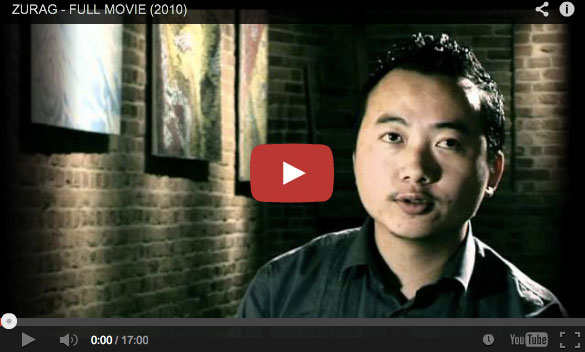
--------------------------------------------------------------
Dr. Georg Goes
Museum director, Museum Baruther Glashütte Museumsleiter
Museum director, Museum Baruther Glashütte Museumsleiter
Media information and glass studio Baruther
"HUN = Humans“ – painting by the Mongolian artist Otgonbayar Ershuu
Museum Baruther Glashütte, 7/19- 8/31/2014
This
special exhibit could also be provocatively titled „The Mongols are
coming.“ It will display works by the Mongolian artist Otgonbayar
Ershuu from the 19th of July until the 31st of August 2014. OtGO, born
in 1981, has studied at the Berlin University of Arts. He had
previously worked as miniature painter in his home country. Through
their clear rules and close relation with tradition commissioned
religious paintings enabled OtGO to mature and develop into a
contemporary painter. These religious paintings continue to have an
impact on his work.
The meaning of meditation is strongly palpable in the Mongolian and Buddhist miniature painting respectively as well as in the current work of the renown contemporary artist. The transition and development from religious commissional work to the monumental civilization-critical acryl painting can be easily reconstructed in the exhibition.
Next to small sheets of Buddhist divinities and a Kamasutra-miniature the exhibit also displays a rarely shown scroll-painting of impressive size – around 6,5 x 2 meters. In both cases, the utilized tools and painting process have played an important role in the development of the motif. Miniatures which tackle the world of Kamasutra in a contemporary fashion occupy a special position.
While the filigree religious miniatures of Thanka-motives center around a divinity, the scroll-painting and four additional works of his current creative period depict a myriad of single figures: humans eating each other and fighting against lions, next to a bear and an elephant, which are being dislodged as kings of the animals and harassed in their dignity. The figures of OtGO, having been painted without a magnifying glass according to tradition coalesce into an almost textile fabric of blazing color with long-distance effect. Four additional panel paintings beguile the onlooker in their color and motifs, seemingly depicting the endangerment of nature.
One reason for OtGO to exhibit his works in the museum village Baruther Glashütte is that the city of Baruth/Mark entertains a partnership with the Mongolian city Morun (Mörön). The fortieth anniversary of the German-Mongolian diplomatic relations serve as a second reason to introduce the paintings of OtGO to a wider public.
The inauguration will take place in the exhibition center at the Hüttenbahnhof in the museum village Baruther Glashütte on the 19th of July 2014 at 3 pm. We are expecting guests from the Mongolian embassy.
The artist will give a talk on the topic “Miniature Painting of Mongolians” on the 10th of August at 3 pm.
The meaning of meditation is strongly palpable in the Mongolian and Buddhist miniature painting respectively as well as in the current work of the renown contemporary artist. The transition and development from religious commissional work to the monumental civilization-critical acryl painting can be easily reconstructed in the exhibition.
Next to small sheets of Buddhist divinities and a Kamasutra-miniature the exhibit also displays a rarely shown scroll-painting of impressive size – around 6,5 x 2 meters. In both cases, the utilized tools and painting process have played an important role in the development of the motif. Miniatures which tackle the world of Kamasutra in a contemporary fashion occupy a special position.
While the filigree religious miniatures of Thanka-motives center around a divinity, the scroll-painting and four additional works of his current creative period depict a myriad of single figures: humans eating each other and fighting against lions, next to a bear and an elephant, which are being dislodged as kings of the animals and harassed in their dignity. The figures of OtGO, having been painted without a magnifying glass according to tradition coalesce into an almost textile fabric of blazing color with long-distance effect. Four additional panel paintings beguile the onlooker in their color and motifs, seemingly depicting the endangerment of nature.
One reason for OtGO to exhibit his works in the museum village Baruther Glashütte is that the city of Baruth/Mark entertains a partnership with the Mongolian city Morun (Mörön). The fortieth anniversary of the German-Mongolian diplomatic relations serve as a second reason to introduce the paintings of OtGO to a wider public.
The inauguration will take place in the exhibition center at the Hüttenbahnhof in the museum village Baruther Glashütte on the 19th of July 2014 at 3 pm. We are expecting guests from the Mongolian embassy.
The artist will give a talk on the topic “Miniature Painting of Mongolians” on the 10th of August at 3 pm.
Museum Baruther Glashütte, Hüttenweg 20, 15837 Baruth-Glashütte
Phone. 03370/980914; info(at)museumsdorf-glashuette.
--------------------------------------------------------------
Otgonbayar Ershuu
was born 18th January 1981 in Ulaanbaatar/Mongolia. His great talent
for drawing and painting was recognized early and by the age of 15 he
had his first solo exhibition. From 1998 to 2001 OtGO studied in
Utaanbaatar traditional Mongolian painting. After graduation, he
participated as a painter and restorer on several research trips to
historical sites in Mongolia. In the Buddhist-Lamaist monasteries he
studied different techniques, the iconography of the miniature painting as well as their spiritual backgrounds.
Since 2005 he lives and works in Berlin. 2007-2010 he studied at the Institute for Art in Context, Faculty of Fine Arts, University of Arts in Berlin and graduated in 2010 as Master of Arts. His international exhibitions began in 2001.
OtGO’S first major group of works are the Thangkas, i.e. Miniature paintings whose contents are derived from the gods worlds of Shamanism, Buddhism and Tengriasm, which applies the artist without a sketch directly onto a specially primed canvas. The primer of screens consists of a mixture of carbon black, chalk and milk vodka or brandy. Pigments from minerals or plants are added. Finally, the mixture is bound with glue from Yakskin and applied to both sides of the canvas. Using the special technique developed by OtGO and the state of highest concentration caused about 600 Thangkas. Striking is the mostly eroticized representation of the subjects. A guiding principle of the Mongolian belief is to achieve the “All - unit” by overcoming all of the real world phenomenon.
A second working group consists of approximately 600 pages of comic-like illustrations of the “Secret History of the Mongols” which was written about 800 years ago. It is the oldest and most important literary works of the Mongols, myth, epic and history at the same time. With its miniature illustrations OTGO wanted to do this important work easier to read for all ages of its culture.
“Even as a child I dreamed of colorful, flowers and romping people of lightness and lightheartedness of paradise.” (OtGO)
His third and most recent group of works, starting with the large-scale painting “HUN” (2010-2012), we could entitle as “Paradise Paintings.” “HUN” is an all-over painting of approximately 12000 people and animals interwoven and designed to a condensed panorama-like, vibrant microcosm. Humans and animals are drawn as miniaturelike, individually elements, merge in the picture, however, in a colorful motion-suggestive overall composition similar to a mirror image of the oriented harmony Mongolian culture.
The images presented in Mannheim are showing flying, floating, running humans and animals, isolated and compacted to groups involved in a cosmos of coloristically concise scene set in natural elements. Everything is in motion, change, transformation. OtGO's paintings based on a picturesque expressive language give us an idea of the harmony between man and nature by civilization partially untouched spaces and a feeling of areas of an earthly paradise, which is in some ways consistent with our Western idea of a total harmony or ‘Ganzheit’ of the world.
Since 2005 he lives and works in Berlin. 2007-2010 he studied at the Institute for Art in Context, Faculty of Fine Arts, University of Arts in Berlin and graduated in 2010 as Master of Arts. His international exhibitions began in 2001.
OtGO’S first major group of works are the Thangkas, i.e. Miniature paintings whose contents are derived from the gods worlds of Shamanism, Buddhism and Tengriasm, which applies the artist without a sketch directly onto a specially primed canvas. The primer of screens consists of a mixture of carbon black, chalk and milk vodka or brandy. Pigments from minerals or plants are added. Finally, the mixture is bound with glue from Yakskin and applied to both sides of the canvas. Using the special technique developed by OtGO and the state of highest concentration caused about 600 Thangkas. Striking is the mostly eroticized representation of the subjects. A guiding principle of the Mongolian belief is to achieve the “All - unit” by overcoming all of the real world phenomenon.
A second working group consists of approximately 600 pages of comic-like illustrations of the “Secret History of the Mongols” which was written about 800 years ago. It is the oldest and most important literary works of the Mongols, myth, epic and history at the same time. With its miniature illustrations OTGO wanted to do this important work easier to read for all ages of its culture.
“Even as a child I dreamed of colorful, flowers and romping people of lightness and lightheartedness of paradise.” (OtGO)
His third and most recent group of works, starting with the large-scale painting “HUN” (2010-2012), we could entitle as “Paradise Paintings.” “HUN” is an all-over painting of approximately 12000 people and animals interwoven and designed to a condensed panorama-like, vibrant microcosm. Humans and animals are drawn as miniaturelike, individually elements, merge in the picture, however, in a colorful motion-suggestive overall composition similar to a mirror image of the oriented harmony Mongolian culture.
The images presented in Mannheim are showing flying, floating, running humans and animals, isolated and compacted to groups involved in a cosmos of coloristically concise scene set in natural elements. Everything is in motion, change, transformation. OtGO's paintings based on a picturesque expressive language give us an idea of the harmony between man and nature by civilization partially untouched spaces and a feeling of areas of an earthly paradise, which is in some ways consistent with our Western idea of a total harmony or ‘Ganzheit’ of the world.
--------------------------------------------------------------
CHUHAL NEWS AGENCY
By Tristan Lefilleul
Translation by Amarsanaa Ariumbold
19.10.2012
By Tristan Lefilleul
Translation by Amarsanaa Ariumbold
19.10.2012
Ershuu Otgonbayar:
a Mongolian painter, but an artist of the world
a Mongolian painter, but an artist of the world
In
2010, OtGO founded Zurag gallery in downtown Berlin, which seems to
have made its way through the rich contemporary art scene of the German
capital. The young Mongolian artist is starting to be famous, but not
only in Germany, galleries from countries like France and Sweden
started to exhibit him lately.
Painting Thangkas, miniatures and graphic novels, we could qualify the work of Otgonbayar substantive and “border braking” like the critics would say. With the “Secret history of the Mongols” represented in a 600 pages and 3000 drawings book or with the acrylic painting “HUN”: a 6 by 2 meters canvas picturing a scene where 11,196 humans and animals are sharing the space (currently exhibited at Tsagaandarium), OtGO not only breaks records but transmits to the public a Mongolian essence. Chuhal.mn benefited from his presence in Mongolia to interview him about his life as a painter between Berlin and Ulaanbaatar.
Red Ger gallery will exhibit Otgonbayar’s paintings from the 17th to the 25thof October. RED GER art gallery at KHAN BANK, Seoul Street-25.
What is the difference between creating in Mongolia and in Germany?
When I am in Mongolia, I am home. It is the motherland and for various reasons the creative process here is very good. However, in Germany I have the gallery to manage and a lot of business related work to do besides painting. It is much more stressful and tiring. In order to focus on my work I need to turn off my phone for example. I need to isolate myself from Berlin’s busy life. On the contrary, In Ulaanbaatar, I feel very relaxed. Back there it is difficult to compel with the work at the gallery and the freedom of the artist.
How do you manage your gallery, Zurag, in Germany? What is your vision?
My main goal with the gallery is to promote Mongolian artists in Germany and by extension in the world. I also like to invite foreign artists. In two years I organized 20 exhibitions with artists from Germany, Turkey, Peru etc. My philosophy is not to focus on nationality but to work on arts emerging from countries. It's not Mongolian art; it is art in Mongolia. Centuries ago we could have said that this art is typically from this region or that country, but today things have changed. Contemporary art for instance, doesn't have borders and is not related to a specific technique. Therefore, we won’t speak about Mongolian contemporary art, but about contemporary Art in Mongolia. To give you an example, I could be working in New York, but my work will not be qualified American, it will be a creation made in New York. It is true that cultural background and education have an impact on your work, and I will explain more about this later. So does the place where you stay temporarily. Everything around you has an effect on your work. However, the location does not give the identity of the creation.
Then, according to you, how does your origins and cultural background influence the artist?
Everyone has a different way of perceiving things. The origin and the education of the painter will have most certainly an impact on the way he will draw ideas, feelings and life elements. His perception and understanding of life is in many aspects constructed by his place of origin. For instance, a Mongolian will picture human – horse relations differently than a Frenchman.
In the German documentary about your artwork available on YouTube, we can see many of your paintings filled with human figures. Can you explain to us what you wanted to express?
When we simply look at someone, a girl or man, we cannot understand their essence. And yet they are animated by a world of their own. During these last seven years I wanted to understand and make understand what this inside life is about. In some paintings it questions what is beyond we can see, in a certain way the afterlife.
Could you tell us more about yourself? How did painting entered your life?
I was born in Ulaanbaatar. Although I am a capital city boy, when I was a kid I had the luck to live in the countryside. In that time I wanted to be a nomad. I was fascinated by the herders' life. And I had the chance to discover all the provinces of Mongolia. I decided to make live my fascination through painting. Then I started to paint a lot. Everything that I saw was painted. And after 15 years, I had to make some choices. Although life was difficult I succeeded to sell some paintings and so I decided to be a painter.
How studying in Germany influenced your way of painting?
Everybody speaks of arts education in Italy or in France, but I chose Germany because I liked the way they would teach painting with the sense of details. It was really helpful for my work on miniatures. Moreover, education in Germany was tuition free.
When do you feel the need to paint? How do you deal with the creation process?
When suddenly a new idea pops into my head while I am working on a painting, I immediately start again, because I believe an idea is worth putting onto paper when it is fresh. We could compare the poet with the painter. People can understand a poet's poem through words and if everything could be explained with words everybody will be a poet. For me the colors of my paintings are like the words of a poem. Through colors the idea evolves and progressively you can start to understand the whole idea.
The size of your paintings seems to grow every time you start a new work. Are you trying to reach the immensity of the steppe? Which is what I feel when I am in front of your painting.
I like to paint on big scales because I find the way people approach a large artwork interesting. They are at the same time impressed by the size, and they are also focusing on details. Although I paint miniatures, what I find interesting about big canvas is that public's attention is picked more quickly and permanently.
In Mongolia it is trickier to reach the public's interest because in general they perceive pictorial art as objects of decoration. They would buy an artwork if it is simple and positive. If painters include impressions, the painting will have fewer chances to be purchased. Those who paint happy paintings with a positive composition will have more chances in the market. But life is not always positive. The goal of the painter is also to question himself, to understand why he is painting. Therefore, it implies to work on emotions and feelings felt during his existence.
How do you think art in Mongolia and artists’ conditions need to be improved?
I think that politicians and the State should develop the mechanisms needed to improve artistic and artists’ conditions in Mongolia. By definition artists don't work for money. They work to fulfill their passions and they create for others. They are sometimes the most qualified to express society’s problems. They have an important role to play in various levels.
CHUHAL NEWS AGENCY:
http://chuhal.mn/r/15540/Ershuu-Otgonbayar-a-Mongolian-painter-but-an-artist-of-the-worldPainting Thangkas, miniatures and graphic novels, we could qualify the work of Otgonbayar substantive and “border braking” like the critics would say. With the “Secret history of the Mongols” represented in a 600 pages and 3000 drawings book or with the acrylic painting “HUN”: a 6 by 2 meters canvas picturing a scene where 11,196 humans and animals are sharing the space (currently exhibited at Tsagaandarium), OtGO not only breaks records but transmits to the public a Mongolian essence. Chuhal.mn benefited from his presence in Mongolia to interview him about his life as a painter between Berlin and Ulaanbaatar.
Red Ger gallery will exhibit Otgonbayar’s paintings from the 17th to the 25thof October. RED GER art gallery at KHAN BANK, Seoul Street-25.
What is the difference between creating in Mongolia and in Germany?
When I am in Mongolia, I am home. It is the motherland and for various reasons the creative process here is very good. However, in Germany I have the gallery to manage and a lot of business related work to do besides painting. It is much more stressful and tiring. In order to focus on my work I need to turn off my phone for example. I need to isolate myself from Berlin’s busy life. On the contrary, In Ulaanbaatar, I feel very relaxed. Back there it is difficult to compel with the work at the gallery and the freedom of the artist.
How do you manage your gallery, Zurag, in Germany? What is your vision?
My main goal with the gallery is to promote Mongolian artists in Germany and by extension in the world. I also like to invite foreign artists. In two years I organized 20 exhibitions with artists from Germany, Turkey, Peru etc. My philosophy is not to focus on nationality but to work on arts emerging from countries. It's not Mongolian art; it is art in Mongolia. Centuries ago we could have said that this art is typically from this region or that country, but today things have changed. Contemporary art for instance, doesn't have borders and is not related to a specific technique. Therefore, we won’t speak about Mongolian contemporary art, but about contemporary Art in Mongolia. To give you an example, I could be working in New York, but my work will not be qualified American, it will be a creation made in New York. It is true that cultural background and education have an impact on your work, and I will explain more about this later. So does the place where you stay temporarily. Everything around you has an effect on your work. However, the location does not give the identity of the creation.
Then, according to you, how does your origins and cultural background influence the artist?
Everyone has a different way of perceiving things. The origin and the education of the painter will have most certainly an impact on the way he will draw ideas, feelings and life elements. His perception and understanding of life is in many aspects constructed by his place of origin. For instance, a Mongolian will picture human – horse relations differently than a Frenchman.
In the German documentary about your artwork available on YouTube, we can see many of your paintings filled with human figures. Can you explain to us what you wanted to express?
When we simply look at someone, a girl or man, we cannot understand their essence. And yet they are animated by a world of their own. During these last seven years I wanted to understand and make understand what this inside life is about. In some paintings it questions what is beyond we can see, in a certain way the afterlife.
Could you tell us more about yourself? How did painting entered your life?
I was born in Ulaanbaatar. Although I am a capital city boy, when I was a kid I had the luck to live in the countryside. In that time I wanted to be a nomad. I was fascinated by the herders' life. And I had the chance to discover all the provinces of Mongolia. I decided to make live my fascination through painting. Then I started to paint a lot. Everything that I saw was painted. And after 15 years, I had to make some choices. Although life was difficult I succeeded to sell some paintings and so I decided to be a painter.
How studying in Germany influenced your way of painting?
Everybody speaks of arts education in Italy or in France, but I chose Germany because I liked the way they would teach painting with the sense of details. It was really helpful for my work on miniatures. Moreover, education in Germany was tuition free.
When do you feel the need to paint? How do you deal with the creation process?
When suddenly a new idea pops into my head while I am working on a painting, I immediately start again, because I believe an idea is worth putting onto paper when it is fresh. We could compare the poet with the painter. People can understand a poet's poem through words and if everything could be explained with words everybody will be a poet. For me the colors of my paintings are like the words of a poem. Through colors the idea evolves and progressively you can start to understand the whole idea.
The size of your paintings seems to grow every time you start a new work. Are you trying to reach the immensity of the steppe? Which is what I feel when I am in front of your painting.
I like to paint on big scales because I find the way people approach a large artwork interesting. They are at the same time impressed by the size, and they are also focusing on details. Although I paint miniatures, what I find interesting about big canvas is that public's attention is picked more quickly and permanently.
In Mongolia it is trickier to reach the public's interest because in general they perceive pictorial art as objects of decoration. They would buy an artwork if it is simple and positive. If painters include impressions, the painting will have fewer chances to be purchased. Those who paint happy paintings with a positive composition will have more chances in the market. But life is not always positive. The goal of the painter is also to question himself, to understand why he is painting. Therefore, it implies to work on emotions and feelings felt during his existence.
How do you think art in Mongolia and artists’ conditions need to be improved?
I think that politicians and the State should develop the mechanisms needed to improve artistic and artists’ conditions in Mongolia. By definition artists don't work for money. They work to fulfill their passions and they create for others. They are sometimes the most qualified to express society’s problems. They have an important role to play in various levels.
CHUHAL NEWS AGENCY:
--------------------------------------------------------------
Otgonbayar Ershuu
(Mongolian: Эршүүгийн Отгонбаяр; * 18. January 1981 in Ulan Bator) is a
Mongolian painter. His artist’s name is OtGO.
Life:
He grew up among seven siblings and one adoptive brother and was fascinated by painting ever since his childhood. His talent was discovered and by the age of 15 years he had his own solo exhibitions. Ershuu studied traditional Mongolian Painting in Ulan Bator in 1998. During his academic studies he created around 400 pictures. After his studies he participated in several expeditions to historical sites in Mongolia as a painter and conservator. Ershuu studied the different techniques and iconography of the miniature paintings as well as their spiritual backgrounds at the Buddhist-lamaist monasteries. He has been active as a free lance artist since 1998. In addition to his free artistic works he has created around 600 “research images.” Ershuu has been living in Berlin since 2005. From 2007 to 2010 he studied at the Institute for Art in Context, Faculty of Fine Arts, Berlin University of the Arts and graduated with a Masters of Arts in 2010. Otgonbayar Ershuu has been exhibiting his work in international exhibitions in Japan, Sweden, France, the Netherlands, India, Czech, Switzerland, Germany and Mongolia.
Thangka painting:
OtGO’s Thangkas have not evolved from religious intentions but were rather inspired by the challenge to learn such a demanding as well as traditional technique. A deep fascination with the technology of producing such a work of art as well as his own anticipation of an individual artistic implementation in the face of strict regulations, incited the artist’s ambitions and posed the beginning of a longtime development in the field of Thangka painting. OtGO developed his painting techniques on long journeys through Mongolia. These could be described as a potpourri of experience, endurance and incredible artistic talent. One of OtGO’s unique characteristics is to paint his depictions directly on the canvas thereby evading the process of sketching. After considering that his pictures are only slightly bigger than a slide one perceives clearly how detailed, precise and perfect the painter has to work in order to create such a picture. Otgonbayar Ershuu has created 600 Thangkas of which the majority of the pictures were created in a single attempt. Each streak can only be commenced once and it is barely impossible to correct any mistakes. States of utter concentration need to be maintained despite natural human needs or unpredictable distractions. Mongolian Thangka painting has been miniaturized according to the tradition of its country and even the iconography has been adapted to the diverse existing beliefs. OtGO’s repertoire of figures draws on the theotechny of Shamanism, of Tengerism and Buddhism. Remarkable is also his depiction of mostly erotic themes. One of the principles of the Mongolian belief is the achievement of the “unity of all” by overcoming all antagonisms perceptible in the world of reality. Emblematic of this is the sexual union of man and woman, which bears the seed of a new life. It follows in considering this principal thought that the eroticization of the religious content of images becomes a natural and almost self-evident consequence. Otgonbayar Ershuu takes his topics and divine figures from traditional artistic depictions. His miniature gods are partially details of bigger paintings or pictorial interpretations of a sculpture. They are however always individualized in his unique, very special mode and have developed into real “OtGO’s.” During the production of his Thangkas Otgonbayar Ershuu uses different primers. In order to obtain these it is necessary to pre-treat his canvases. The black primer is a mixtures of carbon black, chalk and vodka or milk liquor. He adds to this a mixture of pigments, minerals and plants. Finally the mixture is bound with glue extracted from yak hide and applied to both sides of the canvas. Even after ten years a “smelling test” regarding these small pictures will reveal the use of carbon black and alcohol to pre-treat the canvas and endows these miniature works of art with a mysterious and antique nature.
Miniature painting:
It is absolutely remarkable in which precise and loving detail Otgonbayar Ershuu fills his canvases. Lively, colorful depictions of paradise, erotica and flocks of horses mesmerize his pictorial surfaces into imaginative compositions, capture and challenge to explore the world of miniature paintings. Otgonbayar Ershuu has created detailed paintings in breathtaking filigree in tempera on canvas. His newest works present a whole new world of creation. The young artist composed a fascinating coexistence of detailed miniature painting and active abstraction of picture elements in acrylic on canvas.
Comic:
One of the longtime works of Otgonbayar Ershuu has been his “Secret History of the Mongols – related in the style of Mongolian painting as a comic.” This comic consists of about 600 pages, which are divided into 12 chapters. Each page features several pictures amounting to a work of about altogether 3000 drawings. The “Secret History of the Mongols” was written about 800 years ago and is considered the oldest and most significant Mongolian work of literature – as myth, epos and chronic all at once. It did not contain any illustrations originally. In order to make this history more comprehensive and interesting for all ages, Ershuu decided to transform the content of this significant work into Mongolian miniature painting. The idea emerged from his belief that the viewing of images is often easier than reading. One of his main concerns during the development of the comic was to portray ethnic features of the Mongols as well as historical facts and artifacts as precisely and genuine as possible. Therefore he had to pursue extensive researches which lead him into various different academic areas. By including miniature painting in his work he intended to capture something characteristically and traditionally Mongolian.
Gallery ZURAG:
Gallery ZURAG, founded in 2010 by Otgonbayar Ershuu is located in the middle of Berlin, one of the world’s most vibrant art capitals. It is the first gallery founded and operated by a Mongol outside of Mongolia.
Movies:
ZURAG – a movie about Otgonbayar Ershuu; Germany/Mongolia 2010; produced by Tobias Wulff (The movie was broadcasted twice in the Mongolian State television in 2011) ZURAG movie online, languages: German and Mongolian
Publications:
- Otgonbayar Ershuu: HEARTFELT HEAVEN. Printed in Hiimori Printing Co., Ltd Ulan Bator Mongolia 2004, ISBN: 99929-74-08-7
- Otgonbayar Ershuu: THE GODS Printed in Hiimori Printing Co., Ltd Ulan Bator Mongolia 2004, ISBN: 99929-74-07-9
Awards:
1996: Awarded with the gold medal “Knowledge” by the culture palace of Mongolian Children institution, Ulan Bator
2004: Awarded as “Best Mongolian National Talent” by the Ministry of Education, Culture and Science of Mongolia
Critiques:
...From time to time his art tilts towards the almost grotesque, as if the picture was so full of humans that they start to devour each other. Whole armies disappear into the mouth of another human; masses of humans wriggle closely around each other and it may either be associated with overpopulation or a perishing global orgy... (Åsa Jonsén newspaper review „Nerikes Allehanda“ 11/17/2007 (Örebro, Sweden)
...Through his studies OtGO has brought miniature painting to new heights. In modifying his position in regard to the picture the onlooker discovers the picture-in-picture composition as if looking through an artistically arranged prismatic telescope, which reveals detailed sceneries with completely independent meanings with every approaching step. This obfuscates the painting’s overall impression of the playful handling of colors and motifs and the peaceful coexistence of stencil-like precise, seemingly light and cheerful elements which may only be perceived from a distance. With each step towards the picture the onlooker discovers a new and diverse aspect of its interiority... (Uwe Ahnert, gallery owner, Collection Freudenberg, Berlin 2009)
Minimundus explains the world to us OtGO will explain Mongolia – Land of the horses - to us. Who else could do it, who else painted half a million horses? (Martina Busch, Berlin 2010)
Solo exhibitions:
- “HOS YUS” Exhibition in the culture palace of the Mongolian Children in Ulan Bator, Mongolia (1996)
- “GODS” Exhibition at the Adelhauser museum in Freiburg, Germany (2007)
- “MONGOLIAN MINIATURE PAINTING” Exhibition at the Mongolia Center in Freiburg, Germany (2007)
- “MONGOLIAN MINIATURE PAINTING” Exhibition at the Deutsche Bank in Berlin, Germany (2007)
- “Paradise felt with my heart” Exhibition in Munich, Germany (2007)
- “OtGO IN ÖREBRO” Exhibition in the Konstfrämjandet gallery Örebro, Sweden (2007) “OTGO IN THE PALACE” Exhibition in Örebro, Sweden (2009)
- “OtGO IN THE PALACE SEEHEIM” Exhibition Konstanz, Germany (2009)
- “THUNDERING HOOVES” Exhibition at the ZURAG gallery in Berlin, Germany (2011)
- “THUNDERING HOOVES” Exhibition in Bonn, Germany (2011)
- “GODS” Exhibition at the ZURAG gallery in Berlin, Germany (2011)
- “MONGOL AYAN – 1” Exhibition in Elsass, France (2011)
- “MONGOL AYAN – 4” Exhibition at the Fischer-Art studio in Leipzig, Germany (2011)
Life:
He grew up among seven siblings and one adoptive brother and was fascinated by painting ever since his childhood. His talent was discovered and by the age of 15 years he had his own solo exhibitions. Ershuu studied traditional Mongolian Painting in Ulan Bator in 1998. During his academic studies he created around 400 pictures. After his studies he participated in several expeditions to historical sites in Mongolia as a painter and conservator. Ershuu studied the different techniques and iconography of the miniature paintings as well as their spiritual backgrounds at the Buddhist-lamaist monasteries. He has been active as a free lance artist since 1998. In addition to his free artistic works he has created around 600 “research images.” Ershuu has been living in Berlin since 2005. From 2007 to 2010 he studied at the Institute for Art in Context, Faculty of Fine Arts, Berlin University of the Arts and graduated with a Masters of Arts in 2010. Otgonbayar Ershuu has been exhibiting his work in international exhibitions in Japan, Sweden, France, the Netherlands, India, Czech, Switzerland, Germany and Mongolia.
Thangka painting:
OtGO’s Thangkas have not evolved from religious intentions but were rather inspired by the challenge to learn such a demanding as well as traditional technique. A deep fascination with the technology of producing such a work of art as well as his own anticipation of an individual artistic implementation in the face of strict regulations, incited the artist’s ambitions and posed the beginning of a longtime development in the field of Thangka painting. OtGO developed his painting techniques on long journeys through Mongolia. These could be described as a potpourri of experience, endurance and incredible artistic talent. One of OtGO’s unique characteristics is to paint his depictions directly on the canvas thereby evading the process of sketching. After considering that his pictures are only slightly bigger than a slide one perceives clearly how detailed, precise and perfect the painter has to work in order to create such a picture. Otgonbayar Ershuu has created 600 Thangkas of which the majority of the pictures were created in a single attempt. Each streak can only be commenced once and it is barely impossible to correct any mistakes. States of utter concentration need to be maintained despite natural human needs or unpredictable distractions. Mongolian Thangka painting has been miniaturized according to the tradition of its country and even the iconography has been adapted to the diverse existing beliefs. OtGO’s repertoire of figures draws on the theotechny of Shamanism, of Tengerism and Buddhism. Remarkable is also his depiction of mostly erotic themes. One of the principles of the Mongolian belief is the achievement of the “unity of all” by overcoming all antagonisms perceptible in the world of reality. Emblematic of this is the sexual union of man and woman, which bears the seed of a new life. It follows in considering this principal thought that the eroticization of the religious content of images becomes a natural and almost self-evident consequence. Otgonbayar Ershuu takes his topics and divine figures from traditional artistic depictions. His miniature gods are partially details of bigger paintings or pictorial interpretations of a sculpture. They are however always individualized in his unique, very special mode and have developed into real “OtGO’s.” During the production of his Thangkas Otgonbayar Ershuu uses different primers. In order to obtain these it is necessary to pre-treat his canvases. The black primer is a mixtures of carbon black, chalk and vodka or milk liquor. He adds to this a mixture of pigments, minerals and plants. Finally the mixture is bound with glue extracted from yak hide and applied to both sides of the canvas. Even after ten years a “smelling test” regarding these small pictures will reveal the use of carbon black and alcohol to pre-treat the canvas and endows these miniature works of art with a mysterious and antique nature.
Miniature painting:
It is absolutely remarkable in which precise and loving detail Otgonbayar Ershuu fills his canvases. Lively, colorful depictions of paradise, erotica and flocks of horses mesmerize his pictorial surfaces into imaginative compositions, capture and challenge to explore the world of miniature paintings. Otgonbayar Ershuu has created detailed paintings in breathtaking filigree in tempera on canvas. His newest works present a whole new world of creation. The young artist composed a fascinating coexistence of detailed miniature painting and active abstraction of picture elements in acrylic on canvas.
Comic:
One of the longtime works of Otgonbayar Ershuu has been his “Secret History of the Mongols – related in the style of Mongolian painting as a comic.” This comic consists of about 600 pages, which are divided into 12 chapters. Each page features several pictures amounting to a work of about altogether 3000 drawings. The “Secret History of the Mongols” was written about 800 years ago and is considered the oldest and most significant Mongolian work of literature – as myth, epos and chronic all at once. It did not contain any illustrations originally. In order to make this history more comprehensive and interesting for all ages, Ershuu decided to transform the content of this significant work into Mongolian miniature painting. The idea emerged from his belief that the viewing of images is often easier than reading. One of his main concerns during the development of the comic was to portray ethnic features of the Mongols as well as historical facts and artifacts as precisely and genuine as possible. Therefore he had to pursue extensive researches which lead him into various different academic areas. By including miniature painting in his work he intended to capture something characteristically and traditionally Mongolian.
Gallery ZURAG:
Gallery ZURAG, founded in 2010 by Otgonbayar Ershuu is located in the middle of Berlin, one of the world’s most vibrant art capitals. It is the first gallery founded and operated by a Mongol outside of Mongolia.
Movies:
ZURAG – a movie about Otgonbayar Ershuu; Germany/Mongolia 2010; produced by Tobias Wulff (The movie was broadcasted twice in the Mongolian State television in 2011) ZURAG movie online, languages: German and Mongolian
Publications:
- Otgonbayar Ershuu: HEARTFELT HEAVEN. Printed in Hiimori Printing Co., Ltd Ulan Bator Mongolia 2004, ISBN: 99929-74-08-7
- Otgonbayar Ershuu: THE GODS Printed in Hiimori Printing Co., Ltd Ulan Bator Mongolia 2004, ISBN: 99929-74-07-9
Awards:
1996: Awarded with the gold medal “Knowledge” by the culture palace of Mongolian Children institution, Ulan Bator
2004: Awarded as “Best Mongolian National Talent” by the Ministry of Education, Culture and Science of Mongolia
Critiques:
...From time to time his art tilts towards the almost grotesque, as if the picture was so full of humans that they start to devour each other. Whole armies disappear into the mouth of another human; masses of humans wriggle closely around each other and it may either be associated with overpopulation or a perishing global orgy... (Åsa Jonsén newspaper review „Nerikes Allehanda“ 11/17/2007 (Örebro, Sweden)
...Through his studies OtGO has brought miniature painting to new heights. In modifying his position in regard to the picture the onlooker discovers the picture-in-picture composition as if looking through an artistically arranged prismatic telescope, which reveals detailed sceneries with completely independent meanings with every approaching step. This obfuscates the painting’s overall impression of the playful handling of colors and motifs and the peaceful coexistence of stencil-like precise, seemingly light and cheerful elements which may only be perceived from a distance. With each step towards the picture the onlooker discovers a new and diverse aspect of its interiority... (Uwe Ahnert, gallery owner, Collection Freudenberg, Berlin 2009)
Minimundus explains the world to us OtGO will explain Mongolia – Land of the horses - to us. Who else could do it, who else painted half a million horses? (Martina Busch, Berlin 2010)
Solo exhibitions:
- “HOS YUS” Exhibition in the culture palace of the Mongolian Children in Ulan Bator, Mongolia (1996)
- “GODS” Exhibition at the Adelhauser museum in Freiburg, Germany (2007)
- “MONGOLIAN MINIATURE PAINTING” Exhibition at the Mongolia Center in Freiburg, Germany (2007)
- “MONGOLIAN MINIATURE PAINTING” Exhibition at the Deutsche Bank in Berlin, Germany (2007)
- “Paradise felt with my heart” Exhibition in Munich, Germany (2007)
- “OtGO IN ÖREBRO” Exhibition in the Konstfrämjandet gallery Örebro, Sweden (2007) “OTGO IN THE PALACE” Exhibition in Örebro, Sweden (2009)
- “OtGO IN THE PALACE SEEHEIM” Exhibition Konstanz, Germany (2009)
- “THUNDERING HOOVES” Exhibition at the ZURAG gallery in Berlin, Germany (2011)
- “THUNDERING HOOVES” Exhibition in Bonn, Germany (2011)
- “GODS” Exhibition at the ZURAG gallery in Berlin, Germany (2011)
- “MONGOL AYAN – 1” Exhibition in Elsass, France (2011)
- “MONGOL AYAN – 4” Exhibition at the Fischer-Art studio in Leipzig, Germany (2011)
--------------------------------------------------------------
OTGONBAYAR ERSHUU
Otgonbayar Ershuu was born in Mongolia in 1981. He started painting as
a child, his most common subject being that of horses, the national
animal of the Mongols, which he depicted in playful drawings and
paintings. It is common practice that children in Mongolia learn to
ride a horse before they learn to walk. This creates a deep familiarity
with these animals, which is reflected and felt in Otgonbayar's
paintings.
Otgonbayar carried his passion for painting throughout his school years and at the age of 15 exhibited his works at the "Cultural Palace of Mongol Children" in Ulaanbaatar. Daily school life, on the other hand, was difficult for the young artist, and during periods of creative projects he routinely failed to attend his classes. Before receiving his high school diploma, the University of Ulaanbaatar accepted him as a student because of his extraordinary artistic abilities. From 1996 to 1998 Otgonbayar studied "traditional Mongolian painting" and received his degree as a painter. Feeling a deep connection with his home country, he decided to learn the craft of Mongolian miniature painting. There was, however, no course of study in this subject, and he acquired the skill within a six-year period of auto-didactic study.
During the years 1998 and 2004, Otgonbayar traveled to Mongolia's historic sites and took part in numerous cultural and social projects. As a member of the "Mongolian Foundation for the War against Poverty" he held workshops for children. In the role of a conservationist, he works against the decay of Mongolia's cultural heritage and in his disciplined self-study as an artist he mastered the traditional techniques and iconographic elements of Mongolian miniature painting. One of these traditionally Mongolian techniques is tangka painting. In this meditative painting process, small images of deities are created - every image must be finished in a single sitting. The final step is always the painting of the eyes: the painterly opening of the eyes "wakes" the deity in the image.
Otgonbayar created 600 images of deities in the traditional tangka technique. He explains that "tangka painting means that the spirit is painting, not the hands, and like meditation it gives new strength and energy." Otgonbayar has been living and working in Berlin as a freelance artist since 2005. Besides the completion of the Master's course "Art in Context" at the University of the Arts Berlin (UDK), he diligently follows his passion for painting. Drawing from the acquired traditional Mongolian techniques, the young artist has created his own unique and distinctive style of modern miniature painting.
"The most important foundation of miniature painting is natural light. In Mongolia, the sun shines about 300 days a year. In Germany, on the other hand, this is a challenge - the sky is almost always dark." (Otgonbayar)
Otgonbayar does not use optical aids for his miniature paintings; special training enables him to paint using nothing but his eyes, even in difficult lighting situations. The level of precision and love for detail that fills Otgonbayar's canvases is impressive. Lively, colorful images of paradise, erotica and herds of wild horses create enchanting and captivating painted surfaces, inviting the viewer to explore these miniature painted worlds. Using tempera paint on canvas, Otgonbayar created detailed works of breathtakingly delicate nature; his most recent paintings present themselves in an entirely new manner: using acrylic on canvas, the young artist composes a fascinating combination of elements of detailed miniature painting and abstraction.
Since September 25th 2010, Otgonbayar became the first Mongol outside of Mongolia to open an art gallery. The name of the gallery defines its philosophy: the Mongolian word ZURAG means image, painting, drawing, photograph and depiction – in short, it encourages diversity of expression. ZURAG Gallery aims to become more than just an exhibition space; it seeks to be a place of cultural and artistic exchange in which the perception of Mongolian culture is sharpened.
“Roaring Hooves” is the name of Otgonbayar ‘s current exhibition: an exciting cross-section through tempera and acrylic paintings of the young artist. Otgonbayar Ershuu has become “a Mongol with a thousand horses…” In colorful herds, they gallop across the canvases and carry us away into a multi-facetted miniature universe. Minimundus shows us the world – Otgonbayar will show us Mongolia, the land of horses. Who else would do it—who else has painted half a million horses?
Otgonbayar carried his passion for painting throughout his school years and at the age of 15 exhibited his works at the "Cultural Palace of Mongol Children" in Ulaanbaatar. Daily school life, on the other hand, was difficult for the young artist, and during periods of creative projects he routinely failed to attend his classes. Before receiving his high school diploma, the University of Ulaanbaatar accepted him as a student because of his extraordinary artistic abilities. From 1996 to 1998 Otgonbayar studied "traditional Mongolian painting" and received his degree as a painter. Feeling a deep connection with his home country, he decided to learn the craft of Mongolian miniature painting. There was, however, no course of study in this subject, and he acquired the skill within a six-year period of auto-didactic study.
During the years 1998 and 2004, Otgonbayar traveled to Mongolia's historic sites and took part in numerous cultural and social projects. As a member of the "Mongolian Foundation for the War against Poverty" he held workshops for children. In the role of a conservationist, he works against the decay of Mongolia's cultural heritage and in his disciplined self-study as an artist he mastered the traditional techniques and iconographic elements of Mongolian miniature painting. One of these traditionally Mongolian techniques is tangka painting. In this meditative painting process, small images of deities are created - every image must be finished in a single sitting. The final step is always the painting of the eyes: the painterly opening of the eyes "wakes" the deity in the image.
Otgonbayar created 600 images of deities in the traditional tangka technique. He explains that "tangka painting means that the spirit is painting, not the hands, and like meditation it gives new strength and energy." Otgonbayar has been living and working in Berlin as a freelance artist since 2005. Besides the completion of the Master's course "Art in Context" at the University of the Arts Berlin (UDK), he diligently follows his passion for painting. Drawing from the acquired traditional Mongolian techniques, the young artist has created his own unique and distinctive style of modern miniature painting.
"The most important foundation of miniature painting is natural light. In Mongolia, the sun shines about 300 days a year. In Germany, on the other hand, this is a challenge - the sky is almost always dark." (Otgonbayar)
Otgonbayar does not use optical aids for his miniature paintings; special training enables him to paint using nothing but his eyes, even in difficult lighting situations. The level of precision and love for detail that fills Otgonbayar's canvases is impressive. Lively, colorful images of paradise, erotica and herds of wild horses create enchanting and captivating painted surfaces, inviting the viewer to explore these miniature painted worlds. Using tempera paint on canvas, Otgonbayar created detailed works of breathtakingly delicate nature; his most recent paintings present themselves in an entirely new manner: using acrylic on canvas, the young artist composes a fascinating combination of elements of detailed miniature painting and abstraction.
Since September 25th 2010, Otgonbayar became the first Mongol outside of Mongolia to open an art gallery. The name of the gallery defines its philosophy: the Mongolian word ZURAG means image, painting, drawing, photograph and depiction – in short, it encourages diversity of expression. ZURAG Gallery aims to become more than just an exhibition space; it seeks to be a place of cultural and artistic exchange in which the perception of Mongolian culture is sharpened.
“Roaring Hooves” is the name of Otgonbayar ‘s current exhibition: an exciting cross-section through tempera and acrylic paintings of the young artist. Otgonbayar Ershuu has become “a Mongol with a thousand horses…” In colorful herds, they gallop across the canvases and carry us away into a multi-facetted miniature universe. Minimundus shows us the world – Otgonbayar will show us Mongolia, the land of horses. Who else would do it—who else has painted half a million horses?
(Translation by Annika Rixen)
--------------------------------------------------------------
Dr. Eva Gerhards
Adelhauser Museum of Ethnology Museum, Freiburg 2007
Adelhauser Museum of Ethnology Museum, Freiburg 2007
OTGONBAYAR ERSHUU
Otgonbayar Ershuu was born in 1981 at the city of Ulaanbaatar. His
interest for painting and creating had started early at his childhood
and remained as his passion. Soon his talent was developed and revealed
meanwhile he started having his exhibitions from his childhood by 15
years old.
He studied Mongolian style paintings in Ulaanbaatar. Under his studying period he painted more than 400 paintings and after the graduation he took part in expedition journeys to Mongolian historical and memorial places, learning and studying different methods and techniques of traditional painting of iconography and its’ historical periods of development at the Buddhist temples.
His paintings includes his own paintings of free thinking and even more than 600 paintings of studies as miniature, which can be found on his website. His main wish is to contribute to cultural level on peoples’ spiritual foundations and painted iconographical as miniature.
Otgonbayar received many acceptances’ and rewards for his works, paintings and amongst them are: ”Erdem” gold medal of ”Mongolian Children’s’ Palace” and title of ”Mongolian best folk talent”.
His works are familiar to several exhibitions not just in Mongolia even in Tokyo (Japan) Berlin, Munchin, Freiburg, Konstanz (Germany), Stockholm, Örebro (Sweden) Encishaim (France) Prague (Czech Republic) and Amsterdam (Netherlands).
He studied Mongolian style paintings in Ulaanbaatar. Under his studying period he painted more than 400 paintings and after the graduation he took part in expedition journeys to Mongolian historical and memorial places, learning and studying different methods and techniques of traditional painting of iconography and its’ historical periods of development at the Buddhist temples.
His paintings includes his own paintings of free thinking and even more than 600 paintings of studies as miniature, which can be found on his website. His main wish is to contribute to cultural level on peoples’ spiritual foundations and painted iconographical as miniature.
Otgonbayar received many acceptances’ and rewards for his works, paintings and amongst them are: ”Erdem” gold medal of ”Mongolian Children’s’ Palace” and title of ”Mongolian best folk talent”.
His works are familiar to several exhibitions not just in Mongolia even in Tokyo (Japan) Berlin, Munchin, Freiburg, Konstanz (Germany), Stockholm, Örebro (Sweden) Encishaim (France) Prague (Czech Republic) and Amsterdam (Netherlands).
(Translation by Altansukh Demberel)
--------------------------------------------------------------
